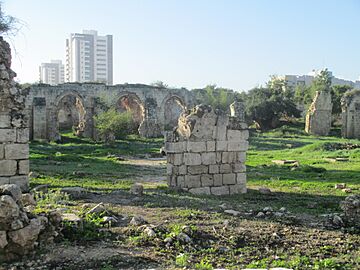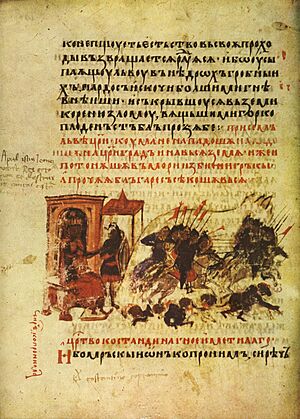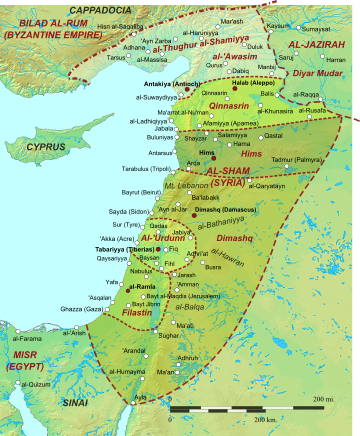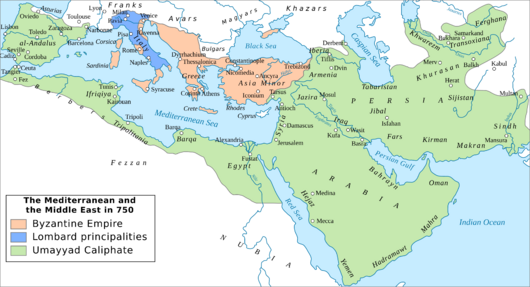Sulayman ibn Abd al-Malik facts for kids
Quick facts for kids Sulayman ibn Abd al-Malikسُلَيْمَان ٱبْن عَبْد الْمَلِك |
|||||
|---|---|---|---|---|---|
|
|||||

Gold dinar minted under Sulayman, possibly in Damascus, in 715 or 716
|
|||||
| 7th Caliph of the Umayyad Caliphate | |||||
| Reign | 24 February 715 – 24 September 717 | ||||
| Predecessor | Al-Walid I | ||||
| Successor | Umar | ||||
| Born | c. 675 Medina, Umayyad Caliphate |
||||
| Died | 24 September 717 (aged c. 42) Dabiq, Umayyad Caliphate |
||||
| Burial | Dabiq, Umayyad Caliphate | ||||
| Wives |
|
||||
| Issue |
|
||||
|
|||||
| House | Marwanid | ||||
| Dynasty | Umayyad | ||||
| Father | Abd al-Malik ibn Marwan | ||||
| Mother | Wallada bint al-Abbas | ||||
| Religion | Islam | ||||
Sulayman ibn Abd al-Malik (born around 675, died September 24, 717) was the seventh Caliph of the Umayyad Caliphate. He ruled from 715 until his death. He was the son of Caliph Abd al-Malik and Wallada bint al-Abbas.
Sulayman started his career as the governor of Palestine. During this time, he was mentored by the religious scholar Raja ibn Haywa. He also became friends with Yazid ibn al-Muhallab, who was an opponent of al-Hajjaj ibn Yusuf. Al-Hajjaj was a powerful leader under Sulayman's brother, Caliph al-Walid I. Sulayman did not like al-Hajjaj's influence. As governor, Sulayman founded the city of Ramla and built the White Mosque there. Ramla became the new capital of Palestine.
When Sulayman became caliph, he removed many governors and generals appointed by his predecessor. These leaders had expanded the Caliphate to its largest size. Among them were Qutayba ibn Muslim, who conquered Transoxiana (Central Asia), and Muhammad ibn al-Qasim, who conquered Sind (western India). Qutayba was killed by his own soldiers, and Muhammad ibn al-Qasim was executed. In the west, Sulayman removed Musa ibn Nusayr, who conquered the Iberian Peninsula (Spain). He also had Musa's son, Abd al-Aziz, assassinated.
Even though Sulayman continued the military policies of earlier caliphs, the Caliphate's expansion mostly stopped during his rule. This was partly due to strong resistance in Central Asia and the loss of Arab military leadership after Qutayba's death. Sulayman focused his military efforts on the Byzantine Empire. This led to the siege of Constantinople in 717–718, which ended in a major defeat for the Arabs.
Sulayman died in Dabiq during the siege. His oldest son, Ayyub, who was supposed to be his successor, had died before him. Sulayman then made an unusual choice. He named his cousin, Umar, as the next caliph, instead of one of his own sons or brothers.
Contents
Early Life and Family Background
Sulayman was likely born in Medina around 675. His father, Abd al-Malik ibn Marwan, was from the Umayyad clan. His mother, Wallada bint al-Abbas, was related to a famous Arab tribal leader. Sulayman spent some of his childhood in the desert with his mother's relatives.
When Sulayman was born, the Caliphate was ruled by his distant cousin, Mu'awiya I. Mu'awiya I had founded the Umayyad dynasty in 661. After Mu'awiya I's successors died, the Umayyad government faced problems. Many provinces supported Abd Allah ibn al-Zubayr as caliph instead. The Umayyads, including Sulayman, had to leave Medina and became refugees in Syria. There, loyal Arab tribes supported Sulayman's grandfather, Marwan I, as caliph. By 685, Marwan had brought Syria and Egypt back under Umayyad control. His son, Abd al-Malik, Sulayman's father, later reconquered the rest of the Caliphate by 692.
Governor of Palestine
At some point, Sulayman's father, Abd al-Malik, made him governor of Jund Filastin (the military district of Palestine). This was a position Abd al-Malik himself had held earlier. Sulayman remained governor of Palestine throughout his brother al-Walid's rule, which lasted until 715.
During his time as governor, Sulayman became close with Raja ibn Haywa al-Kindi. Raja was a religious scholar who had helped build the Dome of the Rock in Jerusalem. Raja became Sulayman's teacher and main advisor.
Sulayman did not like the strong influence of al-Hajjaj ibn Yusuf over Caliph al-Walid. Al-Hajjaj was the powerful governor of Iraq and the eastern parts of the Caliphate. Sulayman became friends with al-Hajjaj's opponents. For example, in 708 or 709, Sulayman gave shelter to Yazid ibn al-Muhallab. Yazid had been imprisoned by al-Hajjaj but escaped to Palestine. Yazid used his tribal connections to get Sulayman's protection. Sulayman even paid a fine for Yazid and sent him to the Caliph with a plea for forgiveness. Yazid became a close friend and advisor to Sulayman. He stayed with Sulayman for nine months and greatly influenced him against al-Hajjaj.
Founding Ramla: A New Capital
As governor, Sulayman founded the city of Ramla to be the new capital of Palestine. It replaced Lydda, which was the original capital. Ramla remained the capital of Palestine for centuries.
Sulayman's reasons for building Ramla were both personal and practical. Lydda was an old and busy city, but it might not have had enough space for new, large buildings. Also, agreements from the time of the Muslim conquest may have prevented him from taking land inside Lydda. Some historians suggest that Lydda was "too Christian" for the Umayyad rulers. Sulayman wanted to build a great city, like his father and brother had done with famous mosques. Building Ramla was his way to leave a lasting mark on Palestine.

The first building Sulayman put up in Ramla was his palace. This palace also served as the main office for Palestine's government. At the center of the new city, he started building a large mosque, later known as the White Mosque. This mosque was finished during the rule of Caliph Umar ibn Abd al-Aziz.
Ramla quickly grew into an important economic center. It became a market town for farm products and a place for dyeing, weaving, and pottery. Many Muslim scholars also lived there. Sulayman built an aqueduct, called al-Barada, to bring water to Ramla from about 10 kilometers away. Ramla took over from Lydda as the main trading center of Palestine. Many people from Lydda, including Christians, Samaritans, and Jews, were moved to the new city. Some accounts say Sulayman even destroyed houses in Lydda to make people move to Ramla.
Jerusalem, about 40 kilometers southeast of Ramla, remained a very important religious place. Sulayman also ordered the building of public places there, like a bathhouse for Muslims to use before praying at the Dome of the Rock.
Becoming Caliph
In 714, Caliph al-Walid I tried to make his own son, Abd al-Aziz, his successor. This would have changed the plan set by Sulayman's father, which made Sulayman the next in line. Al-Walid offered Sulayman money to agree, but Sulayman refused. Al-Walid then asked his governors to recognize Abd al-Aziz, but only a few agreed.
Al-Walid died shortly after, on February 24, 715. Sulayman received the news and became caliph without anyone opposing him. He took oaths of loyalty in Ramla and Damascus. He chose to continue governing from Palestine, where he was "much beloved," instead of Damascus, the usual capital.
Changes in Leadership
In his first year, Sulayman replaced most of the governors appointed by al-Walid and al-Hajjaj. It's not fully clear why he did this. It might have been because he didn't trust them, or he wanted to put his own loyal people in charge. Some historians believe Sulayman favored the Yamani tribal group, while others say he just wanted to remove those connected to al-Hajjaj.
One of his first decisions was to make his friend, Yazid ibn al-Muhallab, the governor of Iraq. Sulayman saw Yazid as his own powerful leader, similar to how al-Hajjaj had been for al-Walid. Yazid showed a strong preference for the Yamani group.
Qutayba ibn Muslim, a general who had conquered Transoxiana, was confirmed in his position by Sulayman. However, Qutayba was worried he would be dismissed. He led his troops in a rebellion against Sulayman, but his soldiers, tired of constant wars, turned against him. Qutayba was killed in August 715. Another general, Muhammad ibn al-Qasim, who conquered Sind, was also dismissed and later tortured to death.

In the west, Sulayman removed Musa ibn Nusayr, the governor of North Africa and conqueror of Spain. Musa was imprisoned, and his son, Abd al-Aziz, who governed Spain, was assassinated in March 716 on Sulayman's orders. Sulayman then took control of Musa's family wealth.
Military Campaigns and Challenges

Sulayman continued the military expansion policies of earlier caliphs. However, the Caliphate's territorial growth mostly stopped during his short rule.
Campaigns in the East
In Transoxiana, no major conquests happened for about 25 years after Qutayba's death. The Arabs even started to lose some territory. Sulayman ordered his army to withdraw from certain areas. Historians believe this military slowdown was due to a lack of strong leadership after Qutayba and more effective resistance from local groups.
In 716, Yazid ibn al-Muhallab tried to conquer the regions of Jurjan and Tabaristan along the southern Caspian Sea. These areas were ruled by local Iranian families and had largely remained independent. Yazid's army, which included Syrian troops for the first time in this region, defeated some local groups and took control of Jurjan. However, the ruler of Tabaristan, Farrukhan the Great, and his allies fought back. Yazid eventually withdrew his troops in exchange for a tribute payment from Farrukhan. Tabaristan remained independent of Arab rule until 760.
The Siege of Constantinople
Sulayman's main military focus was the ongoing war with the Byzantine Empire. Byzantium was the largest and strongest enemy of the Caliphate, and it was right next to Syria, the center of Umayyad power. Earlier attempts to capture the Byzantine capital, Constantinople, had failed. However, the Umayyads had been gaining ground since 692, taking control of Armenia and other areas. By 712, the Byzantine defenses were weakening, and Arab raids went deeper into Asia Minor.

After al-Walid I died, Sulayman pushed even harder to capture Constantinople. In late 716, Sulayman gathered a huge army in Dabiq in northern Syria. From there, he directed the massive war effort against the Byzantines. He was too sick to lead the campaign himself. So, he sent his half-brother Maslama ibn Abd al-Malik to besiege Constantinople by land. He ordered Maslama to stay until the city was conquered. At the same time, the Arab commander Umar ibn Hubayra al-Fazari launched a naval attack on Constantinople.
Sulayman's efforts failed. The Byzantines pushed back the Umayyad fleet in the summer of 717. Maslama's army continued the siege, but more Umayyad fleets sent to help were destroyed in 718. An Umayyad relief army was also defeated. Maslama's army finally withdrew from Constantinople in August 718. The huge losses from this campaign led to the Umayyads pulling back from some captured Byzantine areas. However, Umayyad raids against Byzantium started again by 720. The goal of conquering Constantinople was largely given up after this defeat.
Death and Succession
Sulayman died in Dabiq in September 717 and was buried there. He became ill after returning from Friday prayers and died a few days later.
Sulayman had chosen his oldest son, Ayyub, as his successor in 715 or 716. This was after his brother and possible successor, Marwan al-Akbar, had died. However, Ayyub died in early 717 from a plague that affected Syria and Iraq. This same plague may have caused Sulayman's death.
On his deathbed, Sulayman thought about naming his other son, Dawud, as successor. But Raja, his advisor, told him not to. Dawud was away fighting in Constantinople, and it was not clear if he was still alive. Raja advised Sulayman to choose his cousin and advisor, Umar. Raja described Umar as a "worthy, excellent man and a sincere Muslim." To prevent problems between Umar and Sulayman's brothers, Yazid ibn Abd al-Malik was named as Umar's successor.
Sulayman's choice of Umar over his own brothers was unusual. It went against the idea that the caliph's office would stay within Abd al-Malik's direct family. Raja was given the task of making sure Sulayman's wishes were followed. He made Sulayman's brothers accept Umar by threatening to use force when they protested. Some historians believe Raja's role in this succession might be exaggerated in historical accounts.
Legacy of Sulayman
It is hard to fully understand Sulayman's rule because it was so short. Some historians say his short reign allows for different interpretations of his actions. While some emphasize his support for the Yamani group and opposition to the Qays, others see his appointments as a way to strengthen his control by putting loyal people in power. Historians generally agree that Sulayman continued the expansionist policies of his predecessors.
Sulayman was known for his excellent Arabic speaking skills. Despite his lifestyle, he was sympathetic to religious people. He also built ties with religious opponents of al-Hajjaj in Iraq. He was generous with money towards the Alids, who were close relatives of the Islamic prophet Muhammad. He appointed Abu Bakr ibn Muhammad al-Ansari, a religious figure from Medina, as governor of that city. This was notable because Abu Bakr's family had been involved in a rebellion against an earlier caliph, Uthman, whose death was a rallying point for the Umayyad dynasty.
In poems from his time, Sulayman was sometimes seen as a Mahdi (a "rightly guided one") who would bring justice. This idea might have been linked to the upcoming 100th year of the Hijrah (the start of the Islamic calendar) and hopes for the conquest of Constantinople during his rule. Some sayings attributed to Muhammad connected the conquest of Constantinople with the Mahdi. Sulayman took on this role in his attempt to conquer the city.
Family Life
Sulayman had four wives from different branches of the Umayyad family. His son Ayyub's mother was Umm Aban bint Aban. Another wife, Umm Yazid bint Abd Allah, was the mother of his sons Yazid, al-Qasim, and Sa'id. His wife A'isha bint Abd Allah ibn Amr was the mother of his sons Yahya and Abd Allah. He was also married to Umm Amr, who was the mother of his sons Abd al-Wahid and Abd al-Aziz.
He also had other wives and several sons from slave concubines, including Dawud, Muhammad, al-Harith, Umar, and Abd al-Rahman. In total, Sulayman had fourteen sons. Muhammad, who was twelve when Sulayman died, was the oldest son who survived him.
Sulayman's sons stayed in Palestine and kept strong connections with the local tribal leaders. The Arab tribes in Palestine were very loyal to his family. In 744, they tried to make Sulayman's son Yazid the caliph, but they were not successful. Sulayman's land in Palestine remained with his family until the Abbasid Revolution in 750. After that, the new Abbasid dynasty took his properties. Some of his descendants later lived in the Umayyad lands of Spain.
Images for kids
-
Gold dinar minted under Sulayman, possibly in Damascus, in 715 or 716
-
Remains of the White Mosque in Ramla (pictured in 2014) built by Sulayman and his cousin and successor Umar ibn Abd al-Aziz
-
The Umayyad Caliphate and its provinces (in green), c. 740
-
Dirham of the Umayyad Caliphate, minted in the caliphal province of Sind (probably at Multan), and dated 97 AH/ 715–16 CE: the obverse circular legend reads "In the name of Allah, struck this dirham in al-Hind (
 ) in the year seven and ninety"
) in the year seven and ninety" -
A map of the northern regions of the Caliphate. The area shaded in light brown depicts the expansion into Tabaristan and Jurjan along the southern Caspian coast during Sulayman's reign. The areas shaded in lime green, pink, purple, yellow and orange depict areas conquered under Sulayman's predecessors.
-
A 14th-century illustration of the siege of Constantinople














